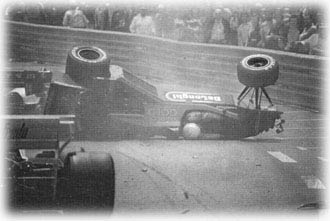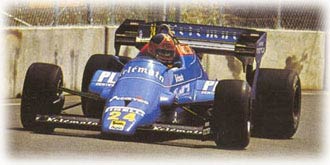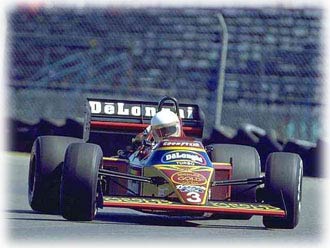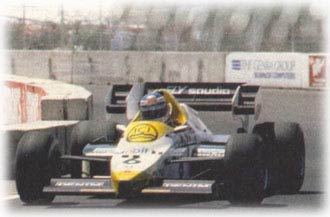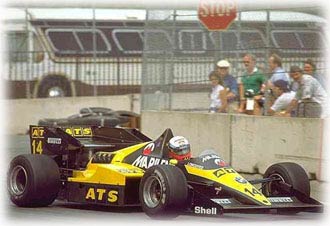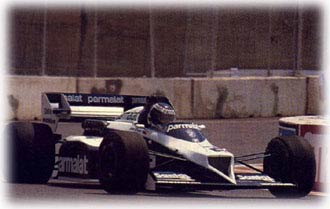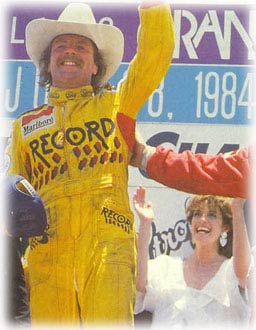| ATLAS F1 Volume 6, Issue 38 | |||
 |
A Race to Remember | ||
| by Marcel Schot, Netherlands | |||
|
Every Grand Prix Venue has its most remembered race; that race where the mighty gods of Formula One diced and dodged to achieve eternal greatness and set the record books straight. But every Grand Prix venue also has remarkable races that were pushed aside in the history books, for no good reason. Atlas F1 writer Marcel Schot reviews, ahead of every Grand Prix this season, one race which should be memorised and valued; that one round in history which makes a Race to Remember
This year, Formula One returns to America on a course that forms a good blend of what US Grands Prix have been like over the years. It incorporates part of the Indianapolis 500 oval, representing the legendary race which was part of the Formula One calendar in the 50s. It also contains quite a few tight and twisty corners, like those at the street circuits in Long Beach, Las Vegas, Detroit, Phoenix and Dallas that hosted US Grands Prix in the 70s, 80s, and early 90s.
Before the race
By the time the Formula One circus arrived in Dallas, the season was halfway through. The McLarens had been the pick of the crop so far, with Alain Prost leading the championship on 35.5 points, followed by teammate Niki Lauda with 24. However, the previous two races at Montreal and Detroit had been won by Nelson Piquet in his Brabham, the Brazilian World Champion closing in fast. Piquet was fourth behind Lotus driver Elio de Angelis, who was just two points behind Lauda. Piquet was closely followed by Ferrari driver Rene Arnoux, who was just one point further back with 17. The other Ferrari was struggling however, Arnoux's teammate Alboreto having scored only 9.5 points.
Almost from the start, there had been many protests against the Dallas Grand Prix. The circuit was laid out on the Texas State Fairground, and twisted around the Cotton Bowl. In essence, it was a collection of 90 degree corners with two hairpins thrown in, bounded by concrete barriers. Most drivers complained of the difficult conditions on the track after practice, with Nelson Piquet saying he wasn't sure what would fall apart first, the cars, the drivers or the track. In fact, the track was showing some cracks in the asphalt, caused by the strong summer heat and the unusual powers of 27 Formula One cars.
Provisional pole was claimed by Lotus driver Nigel Mansell. The sometimes hotheaded Mansell kept his head cool in the Dallas heat, registering a time of 1:37.041, six tenths faster than his teammate Elio de Angelis. Rene Arnoux was surprisingly third in his ill-handling Ferrari, which he claimed was actually an advantage, as his car always handled like this. The Frenchman was followed by a string of Michelin shod drivers, headed by Niki Lauda and including Toleman's Ayrton Senna, Renault driver Derek Warwick and the second McLaren of Alain Prost. World Champion Piquet was struggling in 12th, behind his part-time teammate Corrado Fabi, who had taken his older brother Teo's place in the second Brabham.
On Saturday, it was even hotter and quite a few drivers didn't even bother to go out onto the track, prefering their air- conditioned motorhomes instead. Aside from the injured Brundle and Alliot, who was without a car after crashing his RAM in first qualifying, both leading Lotus drivers were convinced it was impossible to set better times than on Friday. They were joined by the Toleman duo of Ayrton Senna and Johnny Cecotto, and Ligier pilot Francois Hesnault.
The race
It was an early start for the drivers on race day. Because of the intense heat, it had been decided to start the race at 11am. This meant the usual warm-up was to be held at seven in the morning! This ridiculous idea was then further ridiculed by Jacques Laffite, the French clown driver, who managed to show up in full sleeping gear. Instead of wearing his race overalls and helmet, the Williams driver was wearing his pyjamas. However, he could have stayed in bed, because the warm-up was canceled. Overnight repairs to the cracks in the track had been carried out, but it appeared they wouldn't be ready anytime soon.
It was expected that these repairs would only be ready to drive on just thirty minutes before the start of the race. This inspired several drivers, headed by McLaren drivers Lauda and Prost, to issue a protest and demand the race to be canceled. The only strong opponent of the cancellation was Williams driver Keke Rosberg, who had an ace up his sleeve. In his usual relaxed way, the flying Finn told journalists that he didn't know what the fuss was about, as everybody knew that no matter how much they complained, the race would go on, either with or without a decent track surface.
Soon after, Warwick successfully challenged de Angelis for second. The Italian was having problems with his engine, which was misfiring. Mansell had now lost his buffer, with Warwick closing in on the leader. After ten laps, the Renault driver attempted to pass his rival, but he was too ambitious, spinning out and hitting the tyre wall, ending his race. Meanwhile, Rene Arnoux was slicing through the field at a remarkable rate. In just ten laps, the Ferrari driver had moved from 26th to 11th, behind Thierry Boutsen. By this time, another two drivers had left the race. Both Alfa Romeo driver Eddie Cheever and Tyrrell's only remaining driver Stefan Bellof had followed Hesnault's example and hit the wall.
Meanwhile, Andrea de Cesaris (Ligier) and Riccardo Patrese (Alfa Romeo) left the race against the concrete barriers. Dutchman Huub Rothengatter was the first to retire without kissing the concrete. His Spirit was left motionless with a fuel leak after 15 laps. Prost, until then mostly busy with staying out of trouble, harvested his easy goingness and got past Lauda and de Angelis for third. In sixth and seventh now were Nelson Piquet and Rene Arnoux, who were slowly gaining ground on the leading group.
From then on it looked as if Prost could take it all the way without too much trouble. Alas, the Frenchman made a rare error, damaging a wheel and presenting Rosberg the lead on a platter. With Arnoux now well behind in second, the Finn only had to keep his cool and nurse his Williams home for the win. Even though Arnoux closed in on Rosberg considerably in the final part of the race, the race wasn't long enough for the Ferrari driver. After 67 laps and over two hours, Rosberg finished first, just over twenty seconds ahead of Arnoux. Elio de Angelis finished third, a lap behind Rosberg and nearly a lap behind Arnoux.
A further lap back, pyjama-man Laffite brought his Williams home in fourth, well over a minute ahead of Osella driver Piercarlo Ghinzani. Normally these two would have been fifth and sixth, but when Nigel Mansell, to complete his personal drama, ran out of fuel, Laffite and Ghinzani took profit. Mansell then provided another legendary picture when he attemped to push his car across the finishline. Halfway the start finish straight, Mansell collapsed next to his car, totally exhausted.
Conclusion
Of course this whole race was ridiculous. With a track that fell apart underneath the drivers, and drivers hitting the barriers more often than ever before, this race was never going to have a sequel. Rosberg kept his cool in a maelstrom of sliding cars and blistering heat. However, even though Rosberg's victory was quite a legendary one, Arnoux's performance was possibly even better. His amazing rise from 26th to second is one you don't really notice in the statistics, but should be remembered nonetheless. Mansell's collapse finally and perfectly epitomised the drama of this weekend in hell.
For the World Championship things only got more interesting. Both McLarens failed to score, so Elio de Angelis moved to second place with 27 points. followed now by Lauda, Arnoux and Rosberg, all within four points of each other. Eventually the McLarens would decide the title between themselves, but for the moment Dallas increased the interest in the championship.
|
| Marcel Schot | © 2000 Kaizar.Com, Incorporated. |
| Send comments to: schot@atlasf1.com | Terms & Conditions |
